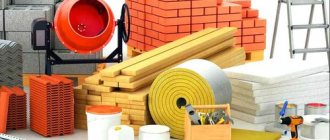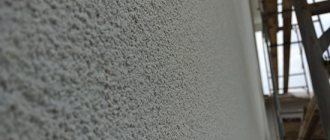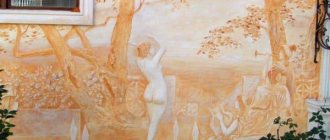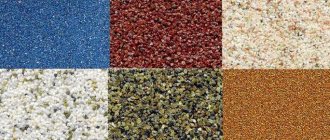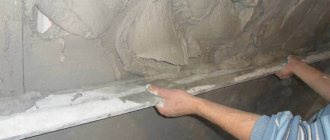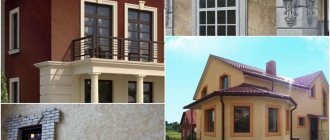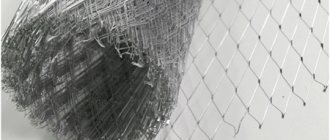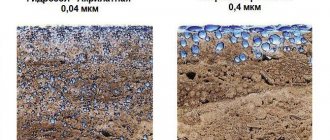Over the past couple of decades, the requirements for building materials regarding their thermal conductivity and insulation abilities have increased significantly. The growing cost of thermal energy, for which you need to pay the market price, forces you to re-arrange thermal insulation even for previously built buildings. We’ll talk about one such technology – heat-insulating plaster (or, more simply, warm plaster) below.
Despite the fact that warm plaster is also used for interior work, it is most often used outside, which imposes a number of restrictions on this material. This information material will be devoted to the composition of the mixture, the nuances of its use, as well as specific brands present on the market.
Insulating plaster – what is it?
Let's look at what warm plaster is. Everyone has long been accustomed to the fact that the classic plaster mixture is a cement-sand mortar containing certain additives. The latter can be lime (to prevent the walls from becoming damp) or all kinds of polymer adhesives (for better adhesion) or even dyes. But what is the mixture for insulating plaster?
In fact, everything is very simple: a filler with a thermal conductivity coefficient significantly lower than that of hardened cement mortar is added to the usual cement-sand mixture (which may also include other polymer components).
Such additives may include:
- expanded vermiculite;
- expanded clay;
- volcanic pumice chips;
- sawdust;
- polystyrene foam granules.
In essence, warm plaster is the same classic plaster mixture that has long been used for finishing buildings and structures, only with additional inexpensive “insulating” components.
Advantages and disadvantages of warm plasters
New properties are added to the familiar material, and since the laying technology has long been proven and is as cheap as possible, the use of such plaster for thermal insulation of buildings provides considerable economic benefits. And this is the first significant advantage of heat-insulating plaster.
The second interesting quality of this material is that such plaster can be used not only as insulation, but also as a humidity normalizer in the room. Some components (for example, sawdust) are able to absorb excess moisture in the air and release it at a reduced concentration of moisture vapor in the atmosphere. And, in addition, warm plaster is an excellent insulator from moisture, protecting capital structures from its effects.
Thirdly, you can easily make a mixture for warm plaster yourself - for this you just need to have the necessary components on hand.
Let us briefly list other useful properties of warm plasters:
- wear resistance;
- environmental safety and cleanliness;
- resistance to temperature changes;
- due to its high adhesive properties, warm plaster can be applied to almost any surface;
- the array forms a single, integral layer, which practically does not require a reinforcing mesh.
However, to be completely objective, it is worth mentioning the disadvantages of thermal insulating plasters. Compared to specialized insulating materials (for example, mineral wool), warm plaster, no matter what it contains as an insulating component, loses by a noticeable margin. To provide the same level of insulation as a stone wool slab, the layer of warm plaster must be twice as thick.
This is why many people call warm plaster a “half solution.” However, if we take into account its economic benefits and technological simplicity, then such a solution may often be quite sufficient.
Varieties by composition
There are 2 types of heat-insulating plaster mixtures:
- Warm cement plaster. This includes all of the above cement-containing mixtures with the specified additives.
- Foamed plaster. A component is added to the cement-containing mixture that causes the formation of foam when interacting with water. The structure of the solution in this case will be similar to foam concrete in both its raw and hardened form. This type of plaster has significantly higher thermal insulation properties, but it requires mandatory subsequent processing - painting, since the porous structure, like a sponge, can effectively absorb moisture.
Rating of the best
Let's consider several main brands of mixtures for warm plasters:
UMKA® UB-21 TM
Here, ceramic silicon balls are used as a heat-insulating filler. Thanks to the porous structure of this filler, Umka warm plaster provides not only reduced thermal conductivity and a high level of heat conservation, but also high-quality sound insulation. In addition, an array of such plaster has a low specific gravity, due to which it is firmly held on the surface of the capital structure even without a reinforcing mesh.
PALADIUM Palaplaster-207
The sand-cement mixture here contains a special component as a heat-insulating filler - foam glass - a porous but durable filler in the form of granules. It does not contribute to the absorption of moisture vapor from the air, is absolutely “indifferent” to fire, and most importantly, it provides increased heat and sound insulation of the surface of the capital structure.
De Luxe "TEPLOLUX"
The plaster mixture is intended for laying on a concrete base or on foam concrete blocks - it is to these surfaces that the composition demonstrates the maximum degree of adhesion. The mixture contains plaster insulation - 3 mm granules of the same foam concrete (so this property of this plaster mixture is quite understandable).
UNIS TEPLON
This is a variant of gypsum plaster. Gypsum itself is significantly less thermally conductive than solid cement. However, to enhance the thermal insulation properties, perlite (or volcanic glass) granules are added to this mixture.
HAGAst AuBenputzPerlit FS-402
This plaster mixture is based on cement, but also contains perlite, which makes it possible to achieve high sound and heat insulation properties. The mixture is specially intended, mainly for finishing surfaces made of gas and foam concrete.
Knauf Grinband
This thermal plaster contains polystyrene foam granules as an insulating filler, with a fraction of no more than one and a half millimeters. In addition, the mixture contains polymer components that reduce the dispersion of the dried mass and prevent contact of polystyrene granules with moist vapor contained in the atmosphere.
Work progress
For thermal insulation plaster to be effective, a number of rules must be followed:
- Carry out high-quality surface preparation.
- The consistency of the water in the mixture must correspond to the proportions described in the instructions.
- Dry plaster is poured into poured water and stirred thoroughly for 5 minutes.
- Mixes are made in small portions, which can be completed in a short period of time.
- Finishing work is carried out in the following temperature range – from +5 to +30°C. Wind, raindrops, and direct sunlight are not allowed when plastering the surface.
- Make sure that all electrical points in the finishing area are de-energized.
- All work is carried out in protective clothing and glasses.
- If plastering was carried out on beacons, they must be removed after completion of the work.
- The thermal insulation layer should not exceed 25 mm. If you need to increase the thickness of the applied plaster, do it in stages - layer by layer, until the required dimensions are reached.
Applying a warm layer
Where is plaster used for wall insulation?
Thermal insulating plaster can be used for finishing capital structures both indoors and outdoors. Let's consider some features of both formats of its use.
Interior work
To finish the interior surfaces of a building, as a rule, a not too thick layer of plaster is applied. And it’s not at all a matter of the desire to save the useful volume of the premises; it’s just that plaster to insulate the walls from the inside will prevent the internal heat of the house from penetrating into the walls themselves.
What matters here is the so-called dew point, namely its exact location. At what point on the wall of a building does the temperature drop so much that the moisture in the air condenses? Obviously, if this point (or rather, an entire plane) is located inside the solid wall, then this will lead to its erosion - water is extremely dispersed, and its vapors are able to penetrate into all the pores and microcracks of concrete and cement masses. These vapors should not be allowed to turn into liquid (and then possibly freeze) directly inside the wall.
Previously, this was achieved through excessive heating of houses, associated with large energy losses (houses, like giant air heaters, heated the street). Now, heat consumption has been significantly reduced, and plaster on the insulation of internal walls can leave the outer layers of concrete masses “unarmed” from exposure to cold and moisture. Warm plaster is used to insulate walls from the inside, but mainly for the purpose of creating soundproofing of rooms. In this case, its layer should not exceed 30-35 mm.
For example, in Sweden, at the legislative level, there is a ban on insulating residential buildings from the inside (on the scale of private apartments).
External
But for finishing facades, heat-insulating plaster is used very widely. Here its layer, as a rule, is never less than 50 mm, and often reaches 100 mm.
In this regard, there are 2 main nuances:
- Such a mass of plaster must be laid on a reinforcing mesh.
- Dried plaster on top must be painted to prevent the absorption of atmospheric moisture by heat-insulating, but at the same time dispersed granules and materials.
Thermal insulation plaster
The process of plastering walls is quite labor-intensive. Often it is necessary to attract specialists who will perform the work better. Simple plastering does not retain heat in the house, which means additional installation of thermal insulation and additional investment will be required.
To get rid of two problems at once, performing only one operation, warm plaster was invented. This is possible thanks to the vermiculite or foam granules contained in the composition. They create a thermal insulation layer.
This material appeared on the construction market relatively recently and is practically unknown. In stores you can find two types of mixtures: for external and internal use.
How to calculate mixture consumption?
As a rule, each manufacturer indicates on the packaging of the plaster mixture the rate of its consumption in terms of 1 m2 of surface to be finished. But if the mixture for plastering is prepared independently, you should keep in mind the average consumption rate (no matter what component composition we are talking about):
25 kilograms of the finished dry mixture when diluted with water should be enough to finish 1-1.4 m2 of wall surface with a 15 mm layer of thermal plaster.
Surface preparation.
Important point: If you want to make a plaster layer on top of another insulation, it is first covered with a fiberglass mesh. Then you can apply the mixture as you would on concrete or brick.
Before the solution begins to cover the walls, they need to be prepared. The scheme is standard. First, the surface is cleaned - old wallpaper, paint, and other materials are removed. Then all irregularities are smoothed out. Apply a primer to a dry wall: it should be selected in accordance with the type of plaster used. Then you need to let the primer dry for at least 24 hours. If there are no large depressions, you don’t have to putty. Small irregularities will be hidden by plaster. If the walls are riddled with potholes, it is better to cover them with pre-reinforcing mesh.
Application technology
Laying a layer of warm plaster is no different from applying traditional plaster. The process consists of 3 parts.
Preparatory stage
At the very beginning, you should prepare the surface. You need to clean it from any dirt, chips, peeling, and fill all cracks with putty. It would be useful to apply a primer layer, which will increase the adhesive ability of the wall.
Preparing the mixture
Each mixture requires its own amount of water for mixing - therefore it is strongly recommended to study the instructions (on the package) before opening it. In addition, some mixtures have a rapid crystallization period after wetting them with water, so you need to be clear about how much time you have for the entire plastering process.
The principle of applying building materials
The plaster material is applied to the wall in layers, each no more than 20 mm thick. In this case, each subsequent layer is applied no earlier than 4 hours after laying the previous one (so that the latter has the opportunity to set).
Calculation of the thickness of the plaster layer
Calculation of the thickness of the required layer of warm plaster for the facade is carried out taking into account SNiP 02/23/2003. It has been established that up to 35% of heat is lost through walls. The total amount of heat loss depends on the total surface area, the difference between the internal and external temperatures and many other parameters.
Thermal conductivity coefficient (λ) takes into account the amount of heat conducted through 1 m³ with a temperature difference between the media.
For the following plaster compositions, this value in descending order (W/(m*°C)) is:
- lime cement with sand - 0.87;
- gypsum - 0.35;
- lime with sand - 0.81;
- gypsum with perlite - 0.23;
- clay with sawdust - 0.29;
- cement with perlite - 0.3, etc.
The thermal conductivity coefficient is equal to unity, i.e. the amount of heat lost will be 1 W for a wall thickness of 1 m. However, if the last indicator is not 1 m, but 20 cm, then the heat loss calculation will be as follows: 1: 0.2 = 5 W. If the temperature difference is not 1°C, but 7°C, then the losses will be higher: 5 x 7 = 35 W. To determine the thermal resistance, use the formula R = d/λ, where d is the thickness of the material.
How to make warm plaster with your own hands?
One of the advantageous features of the material in question is that you can make warm plaster for interior or exterior finishing work with your own hands. Let's consider several options for preparing a mixture for heat-insulating plaster:
Plaster mixture using perlite:
- 1 part cement;
- 1 part sand;
- 4-5 parts perlite.
It is permissible to use PVA glue, but not more than 1% of the total volume.
Mixture using plasticizers:
- 1 part cement;
- 2 parts sand;
- 4 parts vermiculite (volcanic glass, which plays the role of a heat-insulating filler in the mixture);
- 50 gr. PVA glue onto a bucket of cement (10 kg).
In both cases, water should be added until the required mixture consistency is achieved.
Types of heat-insulating mixtures for plastering
Thermal insulation compositions are classified by the type of binder: gypsum, cement, etc., as well as by the type of insulating filler.
Straw based
The material used for a long time is insulating plaster made of clay with straw grain. Straw in clay coating acts as reinforcement and creates voids.
As a result, the plaster coating can be thicker without delamination or cracking. It is applied as a rough layer on the wall over shingles by hand. The coating is breathable, absorbing excess moisture from the air and returning it when the room is dry. Before application, the walls are moistened or sprayed with clay mash. The main disadvantage is the long drying time. The main advantage is a favorable microclimate and low cost.
Sawdust based plaster
Sawdust has long been used for home insulation. They covered the rubble and ceilings. They were added to clay and lime mixtures for coating walls. Sawdust retains heat better than wooden beams, since the thermal conductivity coefficient of sawdust is 0.06 - 0.07 W/(m2•°C), and wood - 0.18. In terms of heat retention, sawdust is much closer to polystyrene foam.
Compositions with sawdust can have a different mineral base - clay, gypsum (Armenian plaster: 3 parts of gypsum, 1 part of sawdust), cement and lime. The main application is indoors. Before mixing the composition, sawdust is sifted through a sieve with a cell diameter of 5 mm.
Polystyrene as filler
A type of polystyrene foam - expanded polystyrene - is used for various purposes, for example, as a filler for anti-stress toys, upholstered furniture, and sleeping pillows. The material is ultra-light (up to 98% air), does not absorb water, and is not food for microorganisms. It is used in cement screeds for floor insulation (1:4:4 - cement/polystyrene granules/sand), and also as a heat-insulating leveling layer (1:3) laid under the screed.
Plaster mixtures with polystyrene are used for work on facades and indoors. They are produced on the basis of cement or cement with lime. Although they do not burn, they can release toxic substances when ignited.
Useful tips and tricks
When applying the plaster mixture, it is extremely important to observe the temperature regime. The composition of warm plaster, due to the presence of a significant amount of filler in it, is less adhesive than classic plaster.
And you need to pay attention:
- on the atmospheric temperature at which work is carried out;
- on the wall temperature;
- on the temperature of the plaster mixture itself.
The ideal option would be if the surface temperature of the wall being finished and the ambient air temperature coincide, and the temperature of the mixture exceeds them by no more than 10°C.
The mixture for warm plaster has a lower specific gravity than the composition of traditional plaster. Therefore, it is necessary to use reinforcing mesh only if a relatively thick layer of this finishing coating is laid (more than 40 mm). And if the wall is plastered without a mesh, the applied mixture should be leveled relative to the pre-set beacons.
Work on the reinforcing layer
The reinforcing plaster layer is intended for internal strengthening of a thick coating, applying it to the facade insulation, at the joints of layers with different shrinkage characteristics, as well as in the case of plastering a building before its shrinkage is completed. For example, a reinforcing layer is made where part of the wall is made of gas silicate blocks, and part of it is made of brick. This section of the plaster coating must be reinforced. It is carried out using a plastic or fiberglass mesh, which has sufficient strength and is not afraid of the internal alkaline environment of the insulating plaster coating. Reinforcement work is carried out inside the solution. A layer of the mixture is applied to the ceilings and walls, then the mesh is laid out and recessed. On the facade walls on top of the insulation, the reinforcement work is slightly different. First, the solution is applied in strokes, then the mesh is attached, and then plastered. They work with spatulas and polishers. When the layer has dried, apply the next one on top of it in the usual way.
Reviews
Private reviews regarding the use of warm plaster for interior and exterior work can be found on any Internet portal that has a repair and construction thematic focus. And the best option is to turn to several resources at once (including forum ones). Only in this way can one obtain objective information and form a holistic opinion regarding the qualitative characteristics of a particular type of application of warm plaster in specific conditions.
Top manufacturers
If we consider building materials from the point of view of manufacturers, the most famous brand is the German company Knauf. This brand has established itself among the first in the post-Soviet space.
The materials are of high quality. All tasks assigned to the material are carried out in accordance with the specified parameters. The main condition is compliance with the rules for using and preparing plaster.
Domestic analogues also cope with the main tasks, to one degree or another. For example:
- Houncliffe contains acrylic and glass. Can be applied to any porous substrate. It has low thermal conductivity, is vapor permeable, and does not accumulate moisture. It is environmentally friendly. The material is relatively new, so it is almost impossible to purchase a fake.
- Thermoum can be used to treat any substrate inside and outside the room. The plaster contains 99% mineral elements, which indicates its environmental friendliness and non-flammability. Pores in the coating occupy 55% of the volume. This allows moisture to not linger in the base. Hydrophobicity allows the product to be used as a moisture barrier for walls.
- Varmmix has high adhesion to any substrate without the use of primers. Unlike the previous option, it can be used for thermal insulation of the façade of a building.
Warm plaster Umka is suitable for indoor work. It is characterized by high strength and moisture resistance. It does an excellent job of insulating walls from noise and cold outside.
Thermal insulating plaster Knauf Grünband
German warm plaster for the facade Grünband can be applied to any base. The application method can be either manual or machine. The latter allows you to speed up the processing process.
The tasks that Grünband copes with:
- waterproofing of facades and rooms with high humidity;
- strengthening the base surface;
- preventing the appearance of cracks during shrinkage of the building or from mechanical impact from the outside;
- decorative design of the base, which only needs to be painted.
The fraction of components does not exceed 1.5 mm. This suggests that the coating differs in coating density and comfort relative to the application of the solution.
